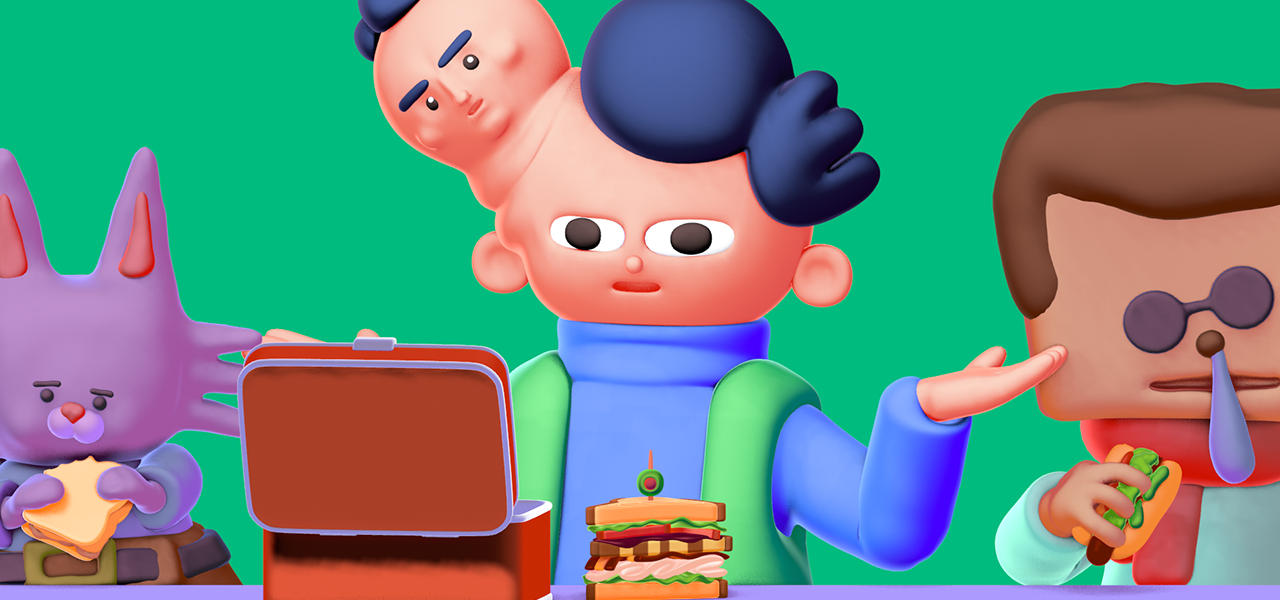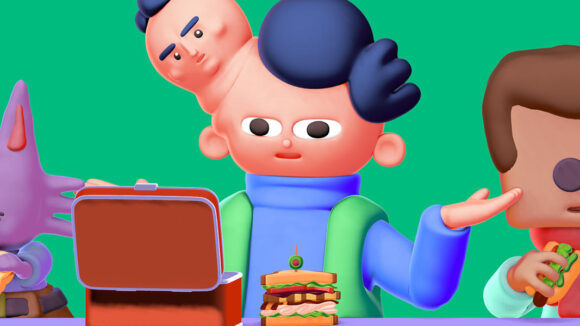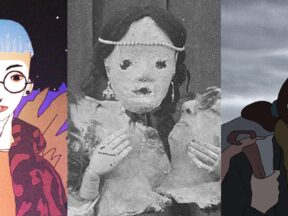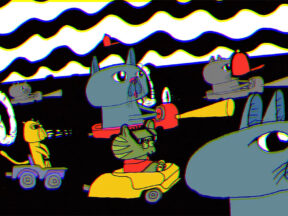

These Minnesota-Based Designers Made Hellavision Television A Home For Experimental Animation
Hellavision Television is a series of participatory events in which artists have a very brief window to create a short, animated clip that is then bunched together with a varying number of other submissions into a non-curated video that is then screened together at festivals, exhibitions, and online.
According to its organizers Peter Steineck and Michael Van Swearingen, Hellavision is a making opportunity first and a screening opportunity second and any interested artist can participate. The program launched in 2017, and 18 episodes have been produced since.
The most recent episode of Hellavision, Earth, is available on Youtube now and features shorts from more than 80 animators. It was put together by L.A.-based filmmaker Dave Merson Hess, who has been contributing to Hellavision for several years and made the music video for “Frutos Rojos” by Los Mundos, a Cartoon Brew Pick back in 2020.
In addition to operating Hellavision, Steineck and Van Swearingen run their own production company in the Twin Cities called Heck Studio. We recently caught up with the pair, and with Merson Hess, to talk about “Earth,” operating an animation studio in Minnesota, and what they’ve learned in putting together 18 episodes of Hellavision over the past six years.
How do you compartmentalize the work you do with Hellavision and running a commercial studio? And what are some of your long-term goals with Heck?
Peter Steineck: We try to be as upfront as possible about the nature of the project and the fact that Hellavision is free. It needs to be its own thing and so we have to separate the two. I think we’re still figuring it out. The nature of Hellavision being open to anybody develops a community and relationships. We’re trying to make Hellavision more and more faceless, and more and more community focused. Ideally, Heck will get creative jobs and we can fall back on this huge community of animators and hire people directly through Heck, creating opportunities for the artists who contributed to Hellavision.
Michael Van Swearingen: Heck would, ideally, be a character animation studio. But the industry is hiccupping, so we’re kind of casting a wide net with motion design to keep us busy. We’re both very strong in motion design. I have a stronger 3d background and Peter has a stronger design background.
So it sounds like Hellavision has become a networking or recruiting tool as well.
Steineck: Yeah. We can tell that lots of times someone has gone to our page, found the artists who appeared in Hellavision, and reached out to them. Sometimes artists think that we told people about them, but that’s rarely the case. Hellavision is a network that is being tapped into by the industry.
Van Swearingen: Everyone’s website and info are available right there on Youtube, so anyone can access them directly straight from the episode. That’s one of the hard jobs actually, to wrangle everyone’s names and get all the credits in there.
There must be challenges to operating an animation studio in the Twin Cities. How has Hellavision helped you connect to the larger animation hubs across the country?
Steineck: Everyone in Minnesota is very isolated and it’s difficult to make things happen here and get animation graduates from MCAD [Minneapolis College of Art and Design] to stay. So we’ve been focusing more on being social. We owe a lot of credit to Sarah Schmidt of Malt Adult, who is an amazing social butterfly animation curator person. She got us really thinking about networking.
Van Swearingen: The thing about having five weeks to follow a prompt is that you just kind of bust your ass that whole time, and there is an immediate friendship that forms with people who have shared that experience. Over time, you develop those relationships online and then when you are finally together in person it’s like you’re a little trauma bonded from those five weeks.
Dave, when did you first hear about Hellavision, and how did you get involved?
Dave Merson Hess: I found out about Hellavision when episode one was posted on Mixed Parts in 2017, which was like a Reddit all about motion and animation. I watched it and I was blown away. I thought it had this raw, weird energy to it that was kind of lacking from more curated animation on the web. Rather than fixating on craft and production value, Hellavision pushed immediacy and personal style. It felt really exciting and punk rock and I loved it. So I started to submit with episode three.
Michael and Peter, you’ve each put together a bunch of episodes of Hellavision. What are you thinking about when organizing an episode?
Van Swearingen: Some things are very high energy, and others are lower energy, and it’s that balance you’re going for. I’ve curated quite a few episodes and it was always about a gut feeling. That said, the capstones were always kind of my favorite. I was always thinking about how we get the audience interested with a cold opening that introduces what you’re about to see, and that usually has to be very high energy. Then to close out the episode, we want to leave people with something to think about and chew on afterward.
Steineck: When I was programming I would play with format all the time. I think it’s episode four, the main title card doesn’t even appear until halfway through. I also like to approach it from a comedic standpoint, so I’m always trying to find the most effective way of letting a person’s joke land. That’s a big deal to me.
And Dave, what were some of the challenges you faced as a newcomer to the process?
Merson Hess: This was the first time I’ve seen under the hood. As a submitter, I was surprised by how much thought I had to put into making sense of what was being submitted. I’ve programmed screenings before, but in doing that there’s a sense of curation. You can pick what you accept and what you leave out. Hellavision is based on this radical invitation: if you make a project responding to the prompt, and you follow the guidelines, you’re in the show. So getting everything in there took a lot of time. The first pass I tried to categorize the films thematically. Then I was really conscious of the audience’s experience, and I didn’t want them to become exhausted watching this, so I worked on pacing. If I had a short that had no dialogue and was a purely visual experience, I could put that after a drop-dead hilarious submission to transition into something very different.
This is the first episode curated by a featured artist. How do you think that worked out?
Van Swearingen: This was the longest episode at like an hour and 15 minutes. I was nervous because some episodes have slower points and others can be over-stimulating. But I have to credit Dave. This one really had a nice flow to it. It’s impressive that he was able to take an hour and 15 minutes of experimental animation and keep the flow exciting and fresh.
Steineck: The segmenting into parts in this episode really helped with the pacing. Episode eight is the next longest one, and it was a slog to get through in the theater. If you’re only seeing like two-minute-long clips, it’s just a constant barrage of random ideas that can feel like too much.
An open call for the next episode of Hellavision will be in August of this year. For more info, check out the Hellavision website here.

.png)

